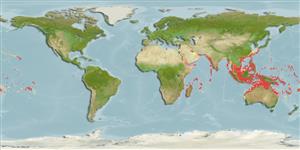分類 / Names
俗名 | 同種異名 | Catalog of Fishes(屬, 種) | ITIS | CoL | WoRMS | Cloffa
Teleostei >
Mulliformes (Goatfishes)
鱸形目 (Goatfishes) >
Mullidae (Goatfishes)
鬚鯛科 (Goatfishes)
Etymology: Upeneus: Greek, ypene, -es = upper lip (Ref. 45335).
More on author: Forsskål.
Environment: milieu / climate zone / depth range / distribution range
生態學
海洋; 半鹹淡水 礁區魚類; 深度上下限 5 - 100 m (Ref. 48636). 熱帶; 26°C - 29°C; 32°N - 33°S, 28°E - 137°W
Indo-Pacific: Persian Gulf (Ref.80050); Red Sea south to East London, South Africa and east to Micronesia and the Hawaiian, Marquesan, and Society islands, north to southern Japan, south to New Caledonia.
印度-太平洋: 紅海南至南非的東倫敦而且東至密克羅尼西亞與夏威夷,馬貴斯群島與社會群島, 北至日本南部, 南至新加勒多尼亞。
Length at first maturity / 大小 / 重量 / 年齡
Maturity: Lm 12.8, range 10 - ? cm
Max length : 28.0 cm TL 雄魚/尚未辨別雌雄; (Ref. 30573); common length : 20.0 cm TL 雄魚/尚未辨別雌雄; (Ref. 5450)
背棘 (總數): 8; 背的軟條 (總數): 9; 臀棘 1; 臀鰭軟條: 7. This species is distinguished by the following characters: D VIII,9; pectoral fins 15-16; gill rakers 7-8 + 19-21 = 27-29; lateral line scales 36-38; body depth at first dorsal fin origin 25-29% SL and at anal-fin origin 21-24% SL; caudal-peduncle depth 9.9-12% SL; maximum head depth 21-26% SL; head depth through eye 18-20% SL; head length 30-31%SL; orbit length 7.0-8.7% SL; upper jaw length 11-13% SL; barbel length 17-21% SL; caudal-fin length 26-30% SL; anal-fin height 15-16% SL; pelvic-fin length 18-21% SL; pectoral-fin length 22-24% SL; first dorsal-fin height 22-25% SL; second dorsal-fin height 14-16% SL; 7-9 total bars on caudal fin, 4-5 brown or dark brown bars on upper caudal-fin lobe, 3 (rarely 4) bars on lower lobe, increasing distally in width with the widest distal-most bar black or dark brown, while the other bars are pale brown or brown; width of largest lower caudal-fin lobe bar and/or pale interspace between distal-most bars equal to or larger than orbit; tip of lower fin lobe pale (bars on both caudal-fin lobes retained on preserved fish); tip of first dorsal-fin dark, the vertical length of the pigmented area similar in size to width of widest lower caudal-fin lobe bar; 2 yellow or pale brown mid-lateral body stripes, one from eye to caudal-fin base, where it joins the proximal upper caudal-fin lobe bar, and the other stripe below from pectoral-fin base to caudal peduncle and continued by proximal-most lower caudal fin lobe bar; 2 dorsolateral brown or pale brown stripes, with the lower one distinct and well-separated from pale body surface, extending from operculum to behind second dorsal fin, the upper one indistinct or hidden and much shorter, beginning below first dorsal-fin origin and bordered dorsally by a horizontal series of pale spots (lateral body stripes not retained on preserved fish); barbels white; white to silvery body. Dark reddish-brown dorsally, white belly, faint yellowish patches along pelvic and anal-fin bases (body pale brown in preserved fish, slightly darker above lateral line) (Ref. 83903).
身體用相當大又有櫛鱗的鱗片是延長; 背鰭分得很開。 嘴巴是些微地小且有凸出上頜; 在下巴下面的一個突出的成對觸鬚。 容易地辨認出在水中的藉由許多線沿著身體, 但是當在魚群中游泳的時候有鯻科魚類的外表當不是攝取食物的時候.(參考文獻 48636)
Euryhaline (Ref. 12743). Inhabits sandy lagoons and sheltered coastal waters. Also found over muddy bottoms (Ref. 5213). Benthopelagic (Ref. 58302). Often in groups (Ref. 9710). In the north-east coast of India, the male to female ratio was 1:1.5 in most months (Ref. 28761). Feeds primarily on small crustaceans. Marketed fresh (Ref. 5284).
廣鹽性.(參考文獻 12743) 棲息於沙的潟湖與掩蔽的沿岸水域。 也發現在泥底部上面。 (參考文獻 5213) 常聚集成群.(參考文獻 9710) 在印度的東北方海岸中,雄魚與雌性的比率在大多數的月份中是 1:1.5 。 (參考文獻 28761) 主要吃小型甲殼動物。 在市場上銷售生鮮地了。 (參考文獻 5284).
Life cycle and mating behavior
成熟度 | 繁殖 | 產卵場 | 卵 | 孕卵數 | 仔魚
印度-太平洋: 紅海南至南非的東倫敦而且東至密克羅尼西亞與夏威夷,馬貴斯群島與社會群島, 北至日本南部, 南至新加勒多尼亞。
Myers, R.F., 1991. Micronesian reef fishes. Second Ed. Coral Graphics, Barrigada, Guam. 298 p. (Ref. 1602)
人類使用
漁業: 商業性; 水族館: 商業性
更多資訊
參考文獻養殖養殖資訊品種遺傳學Electrophoreses遺傳率疾病加工NutrientsMass conversion
工具
特別的報告
下載 XML
網路資源
Estimates based on models
Preferred temperature (Ref.
123201): 24.6 - 29.1, mean 28.1 °C (based on 1854 cells).
Phylogenetic diversity index (Ref.
82804): PD
50 = 0.5000 [Uniqueness, from 0.5 = low to 2.0 = high].
Bayesian length-weight: a=0.00955 (0.00788 - 0.01157), b=3.10 (3.07 - 3.13), in cm total length, based on LWR estimates for this species (Ref.
93245).
營養階層 (Ref.
69278): 3.6 ±0.0 se; based on diet studies.
回復力 (Ref.
120179): 高度, 族群倍增時間少於 15個月 (K=0.3-1.03).
Prior r = 1.19, 95% CL = 0.79 - 1.79, Based on 4 stock assessments.
Fishing Vulnerability (Ref.
59153): Low to moderate vulnerability (25 of 100).
Nutrients (Ref.
124155): Calcium = 57.2 [30.7, 101.6] mg/100g; Iron = 0.56 [0.26, 0.93] mg/100g; Protein = 18.3 [16.1, 20.7] %; Omega3 = 0.192 [0.122, 0.354] g/100g; Selenium = 32.7 [18.1, 64.4] μg/100g; VitaminA = 90 [27, 322] μg/100g; Zinc = 1.36 [0.84, 1.89] mg/100g (wet weight);
